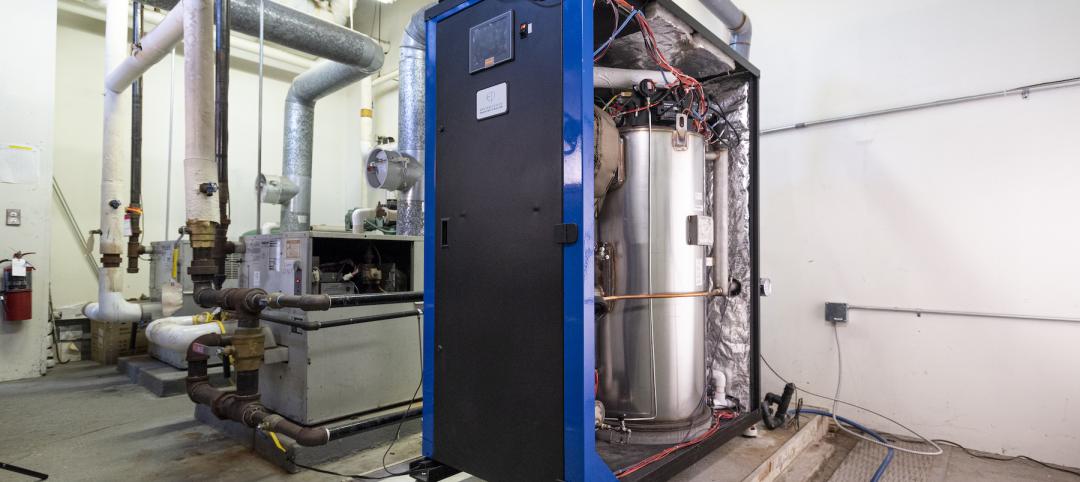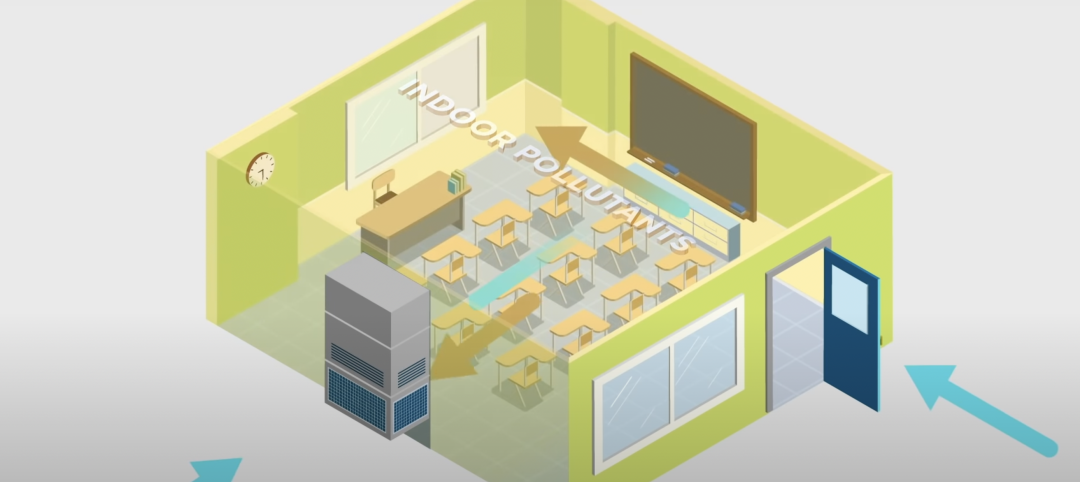The last two decades have introduced new considerations to building owners and developers when planning updates to existing commercial structures or investing in new construction. When accounting for the total cost of ownership and the potential return on investment, owners and developers should consider total energy usage, the lifespan of building systems equipment, the recruitment and retention of occupants, and lease rates.
1. Energy usage and efficiency
According to the U.S. Environmental Protection Agency, the average commercial building wastes 30% of the energy it consumes. This loss is due to equipment use when it isn’t needed—such as lights being left on in empty portions of the building—and outdated technology that consumes more energy than newer models.
In cold climates, temperature control accounts for a majority of the electricity use in commercial buildings. Traditionally, commercial HVAC systems achieve temperature equilibrium by balancing the amount of cold and hot air individually pumped into the building. Also problematic are HVAC systems that require heating and cooling throughout the entire building regardless of occupancy levels.
Today’s technology has produced systems that address both of these issues. Unlike comparable unitary equipment, variable refrigerant flow (VRF) technology provides different speeds of energy flow, rather than a traditional on/off feature, so that the optimal temperature is achieved more efficiently. Studies show that VRF systems decrease energy use anywhere between 15% and 42% compared to traditional HVAC systems. Similarly, a Minnesota state field study on VRF reported 30-40% reduced energy usage during the cold weather months.
Advancements in VRF technology have also substantially improved the reliability and precision of these systems. For instance, Mitsubishi Electric VRF systems are capable of producing simultaneous cooling and heating rather than each individually. This eliminates fluctuating around the optimal temperature by heating, then cooling, then heating again when using traditional units.
The Internet of Things (IoT) allows for the integration of occupancy sensors so electrical systems—including lighting, HVAC, elevators and escalators—are only used as needed. These systems provide real-time feedback on electricity use, and some are capable of predicting occupant habits. According to the Building Owners and Managers Association (BOMA), replacing products that are 10 years old or older has a tremendous impact on the energy use of the system due to the changes in technology within the last decade.
2. Lifespan of equipment
In the past, building owners could expect their systems—such as HVAC units—to last 15+ years with little upkeep. Today’s technology is more sophisticated, with more moving parts. While older systems may deal with neglect, such as dirty air filters and blower wheels, expecting the same from a new unit can decrease its life expectancy and increase the likelihood of downtime. Scheduled maintenance before a problem occurs helps with the upkeep of units and product lifetime expectancy.
The advantages of investing in products whose manufacturers provide regularly scheduled maintenance are three-fold: products will last longer, decreasing the need for replacement within 20 to 30 years; increased tenant retention and satisfaction by minimizing instances of system downtime; and increased value of the building in the instance that you want to sell.
3. Tenant recruitment and retention
The recruitment and retention of tenants and employees has become a priority in today’s commercial real estate market. With an increase in options—due to low unemployment rates, flexibility in where employees are able to work, and an abundance of available office spaces—the stakes have been raised for building owners and developers. Retention, in particular, is a hot-button topic for building owners as they consider the total cost of loosing a key tenant—from lost monthly income, to the space fitout and upgrade costs, to recruitment and advertising expenses.
For tenant-paid utilities, showing a decrease in energy cost due to energy-efficient systems and appliances can have a positive effect on tenant recruitment and retention. Even if the energy saved doesn’t make up for additional costs, tenants are more apt to lease spaces where the owner is energy-conscious.
There is also the reliability of the building systems: Frequent downtime of units can cause frustration among building occupants and lost revenue and productivity for tenants. An hour without power can cost companies more than $100,000 in revenue. Investment in products from Mitsubishi Electric can help reduce such risks and provide better quality and greater efficiency.
4. Lease rates
Installing the latest building systems in a new or renovated building will provide immediate ROI in the form of increased lease rates. When negotiating, tenants are more likely to accept a higher lease rate if it means they have updated equipment, especially if they will be saving money through less expensive operating costs.
Although the trend shows leases are getting shorter, tenants want to avoid the costly, stressful, and time-consuming moving process as much as possible. Therefore, they are more likely to sign or re-sign a lease if they haven’t experienced any negatives—such as repetitive elevator downtime—and the system cost savings show up on their monthly bills.
The times are changing, but that isn’t a negative. Today’s building systems work harder, smarter, and with less energy than ever before. Considering the long-term profitability of your building can set you up for success.
Related Stories
Office Buildings | May 15, 2023
Sixteen-story office tower will use 40% less energy than an average NYC office building
This month marks the completion of a new 16-story office tower that is being promoted as New York City’s most sustainable office structure. That boast is backed by an innovative HVAC system that features geothermal wells, dedicated outdoor air system (DOAS) units, radiant heating and cooling, and a sophisticated control system to ensure that the elements work optimally together.
Office Buildings | Apr 24, 2023
Smart savings: Commissioning for the hybrid workplace
Joe Crowe, Senior Mechanical Engineer, Gresham Smith, shares smart savings tips for facility managers and building owners of hybrid workplaces.
K-12 Schools | Apr 18, 2023
ASHRAE offers indoor air quality guide for schools
The American Society of Heating, Refrigerating and Air-Conditioning Engineers (ASHRAE) has released a guide for educators, administrators, and school districts on indoor air quality. The guide can be used as a tool to discuss options to improve indoor air quality based on existing HVAC equipment, regional objectives, and available funding.
Codes | Mar 2, 2023
Biden Administration’s proposed building materials rules increase domestic requirements
The Biden Administration’s proposal on building materials rules used on federal construction and federally funded state and local buildings would significantly boost the made-in-America mandate. In the past, products could qualify as domestically made if at least 55% of the value of their components were from the U.S.
HVAC | Feb 27, 2023
Turning lost heat to energy is what sets this HVAC boiler apart
Enviro Power’s SmartWatt has been installed in residential and commercial buildings.
Healthcare Facilities | Jan 31, 2023
How to solve humidity issues in hospitals and healthcare facilities
Humidity control is one of the top mechanical issues healthcare clients face. SSR's Lee Nordholm, PE, LEED AP, offers tips for handling humidity issues in hospitals and healthcare facilities.
HVAC | Dec 13, 2022
Energy Management Institute launches online tool to connect building owners with HVAC contractors
The National Energy Management Institute Inc. (NEMI) along with the Biden administration’s Better Air in Buildings website have rolled out a resource to help building owners and managers, school districts, and other officials find HVAC contractors.
75 Top Building Products | Nov 30, 2022
75 top building products for 2022
Each year, the Building Design+Construction editorial team evaluates the vast universe of new and updated products, materials, and systems for the U.S. building design and construction market. The best-of-the-best products make up our annual 75 Top Products report.
K-12 Schools | Nov 30, 2022
School districts are prioritizing federal funds for air filtration, HVAC upgrades
U.S. school districts are widely planning to use funds from last year’s American Rescue Plan (ARP) to upgrade or improve air filtration and heating/cooling systems, according to a report from the Center for Green Schools at the U.S. Green Building Council. The report, “School Facilities Funding in the Pandemic,” says air filtration and HVAC upgrades are the top facility improvement choice for the 5,004 school districts included in the analysis.
Data Centers | Nov 28, 2022
Data centers are a hot market—don't waste the heat!
SmithGroup's Brian Rener shares a few ways to integrate data centers in mixed-use sites, utilizing waste heat to optimize the energy demands of the buildings.
















